The Polaris Ranger 570 is a reliable utility vehicle, but it’s not without its challenges. Common issues include engine performance problems like sputtering or difficulty starting, overheating due to clogged radiators or low coolant levels, and transmission troubles such as slipping or hard shifting. Electrical malfunctions, including dead batteries or faulty wiring, and suspension wear causing uneven tire wear are also frequent complaints. Most of these problems can be addressed with regular maintenance, such as checking fluids, replacing worn parts, and cleaning critical components. Proper care not only solves these issues but can also prevent them from occurring in the first place.
Curious about the best ways to fix these issues or prevent them entirely? Read our comprehensive guide to uncover easy fixes and expert maintenance tips to keep your Polaris Ranger 570 running like new!
This guide explores common “Polaris Ranger 570 problems,” their causes, and practical fixes to keep your UTV running smoothly. Whether you’re dealing with engine trouble, electrical gremlins, or drivetrain quirks, we’ve got solutions to get you back on track.
Common Polaris Ranger 570 Problems
Here’s a breakdown of the most frequently reported issues with the Polaris Ranger 570, along with actionable fixes for each.
1. Engine Performance Issues
Symptoms: Poor acceleration, sputtering, difficulty starting, or stalling.
Causes:
- Dirty or clogged air filter.
- Faulty spark plugs.
- Old or contaminated fuel.
- Fuel pump or injector issues.
Fixes:
- Air Filter Maintenance: Check and clean the air filter regularly. Replace it if it shows excessive dirt or damage.
- Spark Plug Replacement: Inspect the spark plugs for wear. Replace them with high-quality plugs if they’re fouled or worn.
- Fuel System Care: Drain old fuel and refill with fresh, high-octane gasoline. Use a fuel stabilizer if storing the vehicle for extended periods.
- Fuel Pump and Injector Inspection: Ensure the fuel pump and injectors are functioning correctly. Clean or replace them if needed.
Pro Tip: Regular maintenance, including oil changes and filter replacements, can prevent many engine issues.
2. Overheating Problems
Symptoms: Engine overheating or warning lights on the dashboard.
Causes:
- Low coolant levels.
- Clogged radiator.
- Faulty thermostat.
- Malfunctioning fan.
Fixes:
- Coolant Check: Inspect coolant levels and top up with the recommended type if low. Look for leaks in hoses or the radiator.
- Radiator Cleaning: Remove dirt, mud, and debris from the radiator fins to improve airflow.
- Thermostat Replacement: If the thermostat is stuck closed, replace it to restore proper cooling system operation.
- Fan Troubleshooting: Test the cooling fan for functionality. Replace the fan motor or relay if it isn’t working.
Preventative Tip: Clean the radiator and check coolant levels after every off-road trip.
3. Transmission and Clutch Problems
Symptoms: Difficulty shifting gears, slipping transmission, or unusual noises from the drivetrain.
Causes:
- Worn drive belt.
- Misaligned or damaged clutch.
- Low or contaminated transmission fluid.
Fixes:
- Drive Belt Replacement: Inspect the drive belt for wear or damage and replace it if necessary.
- Clutch Alignment and Maintenance: Check for clutch alignment issues and clean or replace damaged components.
- Fluid Change: Drain old transmission fluid and refill with the manufacturer’s recommended type.
Pro Tip: Regularly inspect the drive belt and clutch assembly to catch issues early.
4. Electrical System Malfunctions
Symptoms: Non-functional lights, dead battery, or intermittent electrical issues.
Causes:
- Weak or dead battery.
- Loose or corroded wiring connections.
- Faulty alternator or voltage regulator.
Fixes:
- Battery Health Check: Test the battery with a multimeter. Replace it if it’s not holding a charge.
- Inspect Wiring: Look for loose, corroded, or damaged connections. Tighten or repair them as needed.
- Alternator and Regulator Test: Verify the alternator and voltage regulator are working properly. Replace faulty components.
Preventative Tip: Keep electrical connections clean and dry to prevent corrosion.
5. Suspension and Steering Problems
Symptoms: Uneven tire wear, clunking noises, or difficulty steering.
Causes:
- Worn bushings or bearings.
- Misaligned wheels.
- Damaged tie rods or suspension components.
Fixes:
- Component Inspection: Check bushings, bearings, and tie rods for wear or damage. Replace as needed.
- Wheel Alignment: Realign wheels to ensure even tire wear and improved handling.
- Suspension Maintenance: Tighten loose bolts and lubricate moving parts.
Pro Tip: Regularly inspect suspension and steering components after rough terrain rides.
6. Brake Issues
Symptoms: Reduced stopping power, squealing brakes, or spongy pedal feel.
Causes:
- Worn brake pads.
- Contaminated brake fluid.
- Air in the brake lines.
Fixes:
- Brake Pad Replacement: Replace worn or damaged pads with high-quality replacements.
- Fluid Flush: Bleed and replace brake fluid to ensure optimal performance.
- Air Removal: Bleed the brake lines to remove trapped air.
Preventative Tip: Check brake pads and fluid levels regularly to ensure safety.
7. Starting Problems
Symptoms: Difficulty starting or no response when turning the key.
Causes:
- Weak battery.
- Faulty starter motor.
- Ignition switch issues.
Fixes:
- Battery Maintenance: Ensure the battery is fully charged and replace it if it’s old or weak.
- Starter Motor Test: Inspect the starter motor and replace it if it’s not engaging properly.
- Ignition Troubleshooting: Check the ignition switch and connections. Repair or replace faulty components.
Pro Tip: Keep a portable jump starter handy for emergencies.
General Maintenance Tips for the Polaris Ranger 570
- Follow the Owner’s Manual: Stick to the maintenance schedule recommended by Polaris.
- Keep It Clean: Wash the UTV after muddy rides to prevent dirt buildup in critical components.
- Store Properly: Park in a dry, covered area to protect against weather-related damage.
- Use Quality Parts: Opt for OEM or high-quality aftermarket parts to ensure reliability.
Frequently Asked Questions (FAQs)
Q1: How often should I service my Polaris Ranger 570?
A: It’s recommended to follow the service schedule in your owner’s manual. Typically, this includes oil changes every 50-100 hours of operation and periodic checks of air filters, belts, and other components.
Q2: What type of oil should I use in my Polaris Ranger 570?
A: Use the oil type and viscosity recommended by Polaris, usually a synthetic 5W-50 for most operating conditions.
Q3: Why is my Polaris Ranger 570 making a squealing noise?
A: Squealing noises can often be traced to a worn drive belt, loose components, or brake issues. Inspect these areas and replace or tighten parts as necessary.
Q4: Can I use aftermarket parts for repairs?
A: While aftermarket parts can be cost-effective, it’s best to use OEM parts to ensure compatibility and reliability.
Q5: What should I do if my Ranger 570 won’t start in cold weather?
A: Ensure the battery is fully charged and use a cold-weather oil for better performance. Keeping the vehicle in a garage or using a block heater can also help.
When to Seek Professional Help
While many issues can be resolved with basic tools and some mechanical know-how, some problems require professional attention. If you’re unsure about a diagnosis or lack the tools to fix an issue, consult a certified Polaris technician.
Final Thoughts
By addressing these common “Polaris Ranger 570 problems,” you can enjoy a smoother, more reliable ride. Regular maintenance and timely repairs are key to extending the life of your UTV. If you have additional tips or experiences with the Ranger 570, feel free to share them. Your insights can help fellow riders keep their machines in top shape.

